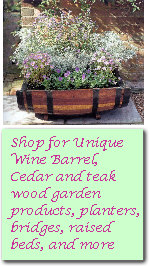|



| |
Vertical gardening is ideal for gardening in the urban city
areas, apartments with balcony, and they are easily accessible for gardeners
with disability or elderly gardeners for ease of enjoying their hobby.
Vertical Gardening, gardening with upright structures,
like the our very own tiered raised bed, can be
easily accessed by all individuals. Many structures, including bamboo fences,
wood fences,
arbors trellises and walls can be
used to create practical and functional gardening spaces, as well as defining
areas, creating boundaries and providing support for plants.
Hanging basket planter and pulley systems can be used to make vertical gardening
attractive and easy to get to. All can be naturally incorporated into any garden
design. There are many advantages of having a vertical garden, including plants such as flowering vines and variegated vines
traditionally grown on upright structures, can be used to create a very
attractive garden.
 |
Vertical gardening can provide privacy and a disguise from
unattractive views. |
 |
Vertical gardening provides excellent air circulation for
the plants. |
 |
Certain pests are not vertical crawlers and you may be able
to prevent some pests from being a problem. |
 |
You can build a vertical garden space as a shaded area.
|
 |
Many plants can be trained to climb vertical structures.
|
 |
You can grow more plants with little space.
|
 |
Plants can be within reach for an individual with
limitations who is unable to garden in a traditional way. |
 |
Many materials used for vertical gardening can be used in
ground-level gardening or raised beds, such as trellises and stakes. If you
are not steady on your feet, be careful about using plant stakes as you may
easily trip and fall. |
 |
Plants which are grown vertically need more frequent
watering, but can be remedied by using mulch at the base of the plant.
|
If you are gardening with some limitations, there are several
factors you need to take into account before selecting seeds, plants and the
type of vertical structure you will be using (Adil, 1994):
 |
Will your plants be grown in a ground-level garden, a
raised bed, a planter box, a tabletop planter, or in a container? |
 |
If the plants won\'92t be at ground level, how high from
the ground will they be planted? |
 |
How tall will the plants be at maturity?
|
 |
Will you be gardening from a seated or standing position,
and how high can you comfortably reach? |
Without some pre-planting mathematics, the results could be
quite frustrating if your plants grow out of reach. Moreover, it's exhausting to
work with arms raised for any length of time. A combination of planting methods
may in fact be necessary (Andil, 1994). For example, if you have a 30" high
planter box, pole beans cannot be planted as the beans will grow out of your
reach. It may be more appropriate to grow a low growing crop in the planter box
instead. It will be critically important to preplan your garden and assess your
limitations, as it would be with anyone, so that you will have a successful
garden that is completely accessible to you. Janeen Advil makes a wonderful
suggestion in her book about location of vertical structures. Make sure the
vertical structures are on the north side of the plant, particularly if you have
sun-loving plants. Another suggestions is to have the vertical structure on the
downwind side of the plants, so that strong winds do not blow over the plants,
but push plants against the supportive structure.
Hanging baskets are another great way to make use of limited
space and create a vertical garden. Baskets can be hung on arbors or other
vertical structures that can support them. If you have limitations in reaching
high objects, ropes and pulleys can be installed so that you can lower your
plants to be able to tend to them and then raise them to the desired height.
With double or triple pulleys, you can make a miniature block and tackle system,
applying some of the things you learned in physics class (or ask someone who was
in a physics class!) to considerably reduce the strength necessary to raise and
lower the basket. You can minimize accidents by tying a safety knot to become
wedged in a pulley and stop a falling container, in the event control is lost.
Selecting Plants for your Garden
Taking into account what you want to
grow and adapting plants that suit your needs and limitations, you can grow
anything. There are many gardening resources to choose from, including the
library, gardening centers and your own experiences. Plant what works for you.
For an individual who may find traditional gardening
difficult, there are some considerations that should be kept in mind:
 |
Select plants that have an interesting texture, color,
scent and form. |
 |
For an individual with limited vision, having plants that
are vivid in color, such as bright red or orange, or have a interesting
texture will allow a person with a vision loss enjoy gardening. Check out the
gardens at Loose Park in Kansas City that was created for individuals who have
a vision loss. Plants that are scented are particularly appealing whether you
have a vision loss or not. |
 |
Select plants that you can easily maintain.
|
 |
Determine how much time you can spend with gardening tasks.
If you do not have the stamina or the strength to keep up with gardening
chores, the garden will suffer. You may also loose interest in gardening.
|
article credit to
Outreach and Extension
University of Missouri
Lincoln University
|
![]() Gardeners' Corner
Kids'
Garden
Sustainable Garden
Contact Us
Gardeners' Corner
Kids'
Garden
Sustainable Garden
Contact Us![]()

